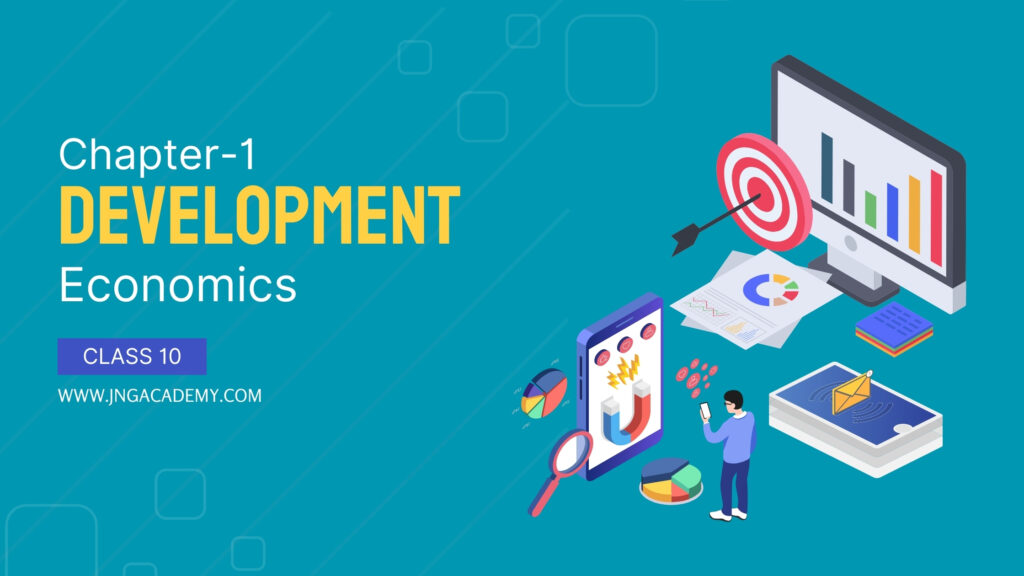Key Learning Outcomes
By the end of this lesson, readers will:
✔️ Understanding that development differs for individuals, societies, and nations.
✔️ Learning the limitations of income-based comparisons.
✔️ Knowing how HDI ranks countries based on overall well-being.
✔️ Realizing the importance of sustainability in development.
Click On The Name To Go To A Specific Topic:
Introduction:
Development refers to the progress or improvement in different aspects of life such as income, education, health, and quality of life. It varies from person to person based on their needs and aspirations.
What is Development?
- Development means growth, improvement, or progress in various aspects of life.
- Different people have different developmental goals (e.g., a farmer wants better irrigation, a businessman wants profit, and a worker wants higher wages).
- National development refers to the overall progress of a country in terms of economic growth, health, education, employment, and infrastructure.
Different People, Different Goals
Development is not the same for everyone.
Example:
- A landless laborer may want more job opportunities.
- A rich businessman may want higher profits and better market access.
- A girl from a village may want better education and equal opportunities.
Conflict in Goals: Sometimes, one person’s development may harm another person. (Example: A factory opening may provide jobs but can lead to pollution).
Income and Other Goals
- Money (Income) is important, but not the only factor in development.
- Other important factors:
✅ Good healthcare
✅ Education
✅ Equality and security
✅ Pollution-free environment
✅ Job security - Example: A teacher may prefer a job with job security and respect over a higher-paying but insecure job.
How to Compare Different Countries or States?
Per Capita Income (Average Income)
- To compare countries, Per Capita Income (PCI) is used.
- Formula: Per Capita Income=Total Income of the Country/Total Population
- World Bank Classification (2023 Data):
- High-Income Countries: PCI above $13,205
- Middle-Income Countries: PCI between $1,086 and $13,205
- Low-Income Countries: PCI below $1,086
- India’s PCI (2023): Around $2,500 (middle-income country).
Limitations of Per Capita Income
- It does not consider inequalities (For example: A country may have high per capita income but huge inequality).
- It does not include non-economic factors like education, health, and environment.

Human Development Index (HDI)
- Developed by United Nations Development Programme (UNDP).
- Measures development based on three key factors:
- Life Expectancy (Health) – Average lifespan of people in a country.
- Education (Literacy Rate & School Enrollment) – Level of education among people.
- Per Capita Income (Economic Factor) – Average income of people.
- Top HDI Countries:
- Switzerland
- Norway
- Iceland
- India’s HDI Rank: Around 134 out of 193 countries.
For More Information: Visit Wikipedia.
Sustainable Development
- Sustainability means using resources wisely so future generations can also benefit.
- Example:
- If groundwater is overused for farming today, future generations may not have enough water.
- Cutting too many trees leads to climate change and loss of biodiversity.
- Sustainable Development Goals (SDGs) were adopted by the United Nations in 2015 with 17 goals (e.g., Zero Hunger, Quality Education, Clean Water, Climate Action).
Important Summary Points
✔️ Development means progress and improvement in living standards.
✔️ People have different development goals.
✔️ Per Capita Income is used to compare countries, but it has limitations.
✔️ HDI (Human Development Index) considers health, education, and income for ranking countries.
✔️ Sustainable Development is necessary to preserve resources for the future.
Interesting Facts
💡 Switzerland has been ranked No.1 in HDI for several years due to high income, great healthcare, and excellent education.
💡 Bhutan uses Gross National Happiness (GNH) instead of GDP to measure development.
💡 India’s literacy rate is around 77.7% (as per 2022 data), while Kerala has the highest literacy rate (~94%).
💡 The fastest-growing economies in 2024 include India, China, and Bangladesh.
Activity (Exercise):
MCQs
Coming Soon…
Fill in the blanks.
Coming Soon…
Match
Coming Soon…
Questions and Answers:
Coming Soon…
Quiz:
Coming Soon…
Supplementary Materials:
Provide downloadable materials for learners to review:
- – PDF Guide: “Coming Soon”
- – Cheat Sheet: “Coming Soon”
- – Video Source: “JNG ACADEMY“
- – Articles: “Blog Page“
FAQs:
1. What is the meaning of Per Capita Income? How is it calculated?
Formula:
Per Capita Income =Total Income of the Country / Total Population
It is used to compare the economic development of different countries.
2. Why is income not the only measure of development? Give two reasons.
Income is important, but other factors also determine development, such as:
a. Health and Life Expectancy: A country with higher income but poor healthcare cannot be considered fully developed.
b. Education and Literacy Rate: Development should ensure access to quality education for all, not just higher income.
3. Define Sustainable Development with an example.
Example:
(i) Overuse of groundwater in farming can lead to a water crisis in the future. Sustainable farming methods such as drip irrigation help conserve water.
4. Explain the Human Development Index (HDI) and its three key indicators.
It includes three key indicators:
(i) Life Expectancy (Health): Higher life expectancy means better healthcare and living conditions.
(ii) Education (Literacy & School Enrollment): Measures the percentage of educated people in a country.
(iii) Per Capita Income (Economic Factor): Average income per person to determine economic well-being.
Note: A country with a higher HDI ranking is considered more developed.
5. Compare the development goals of a farmer, a businessman, and a student.
Wants better irrigation, higher crop yield, fair crop prices, and insurance for crops.
(II) Businessman:
Focuses on higher profits, market expansion, and lower production costs.
(III) Student:
Desires quality education, better career opportunities, and modern infrastructure in schools.
Conclusion: Development goals vary for different people based on their needs and aspirations.
